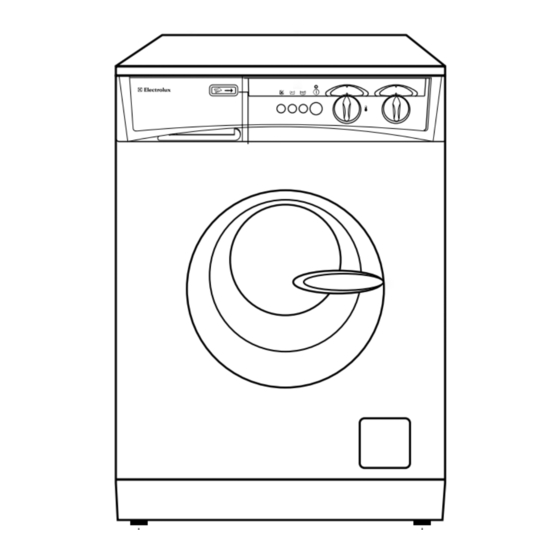
Table of Contents
Advertisement
Advertisement
Table of Contents

Summary of Contents for Electrolux EW 757 F
- Page 1 E W 7 5 7 F...
-
Page 2: Table Of Contents
Dear customer, Transport damages Please read these operating instructions carefully When unpacking the appliance, check that it is not and pay particular attention to the safety notes damaged. If in doubt, do not use it and contact the indicated in the first pages. We recommend that you Service Centre. -
Page 3: Warnings
Warnings The following warnings are provided in the interests of overall safety. You must read them carefully before installing or using the appliance. Installation • Leave the porthole door slightly ajar when the appliance is not in use. This preserves the door •... -
Page 4: Disposal
Disposal Packaging materials This means that they can be recycled by disposing of them properly in appropriate collection containers. The materials marked with the symbol recyclable. Machine >PE<=polyethylene >PS<=polystyrene Use authorised disposal sites for your old appliance. Help to keep your country tidy! >PP<=polypropylene Tips for environmental protection To save water, energy and to help protect the... -
Page 5: Installation
Installation Unpacking 6. Plug all the holes with the plugs which you will find at the back of the appliance or in the envelope containing this manual. All transit bolts and packing must be removed before using the appliance. You are advised to keep all transit devices so that they can be refitted if the machine ever has to be transported again. -
Page 6: Water Drainage
The inlet hose must not be lengthened. If it is too Electrical connection short and you do not wish to move the tap, you will This machine is designed to operate on a 220-230 V, have to purchase a new, longer hose specially single-phase, 50 Hz supply. -
Page 7: Your New Washing Machine
Your new washing machine This new machine meets all modern requirements for effective treatment of laundry with low water, energy and detergent consumption. • The temperature selector dial will allow you to choose the most suitable temperature for your laundry. •... -
Page 8: Use
Control panel 1 Programme chart 5 On/Off button It will help you to choose the most suitable washing Press this button to start the machine. The same programme for your laundry. button is used to switch the machine off. Before selecting a programme or changing an No spin button ongoing programme the machine must be switched off by depressing the On/Off button. -
Page 9: Washing Hints
Washing hints Laundry weights Sorting the laundry The following weights are indicative: Follow the wash code symbols on each garment label and the manufacturer’s washing instructions. bathrobe 1200 g Sort the laundry as follows: napkin 100 g whites, coloureds, synthetics, delicates, woollens. quilt cover 700 g sheet... -
Page 10: Detergents And Additives
Red wine: soak in water and detergent, rinse and Quantity of detergent to be used treat with acetic or citric acid, then rinse. Treat any The type and quantity of detergent will depend on residual marks with bleach. the type of fabric, load size, degree of soiling and Ink: depending on the type of ink, moisten the fabric hardness of the water used. -
Page 11: International Wash Code Symbols
International wash code symbols These symbols appear on fabric labels, in order to help you choose the best way to treat your laundry. Energetic wash Max. wash Max. wash Max. wash Max. wash temperature temperature temperature temperature 95°C 60°C 40°C 30°C Hand wash Do not... -
Page 12: Operating Sequence
Operating sequence Before washing your first load of laundry, we recommend that you run a cotton cycle at 60°C, with 5. Select the required option(s) the machine empty, in order to remove any manufacturing residue from the drum and tub. Depress button and/or and/or... -
Page 13: Washing Programmes
Programme table Washing programmes for cotton and linen Load: 6 kg Consumptions* Additional Programme Temp. Fabrics functions Energy Water Duration min. 60°-90° WHITES WITH PREWASH, for example work garments, sheets, household linen, underwear, towels 60°-90° WHITES WITHOUT PREWASH, for example household linen, sheets, shirts, underwear COLOUREDS WITH PREWASH, 40°-60°... -
Page 14: Washing Programmes
Programme table Washing programmes for synthetics, mixed fabrics, delicates and wool Load: 3 kg, wool 2 kg Addi- Consumptions* tional Programme Temp. Fabrics func- Energy Water Duration tions min. 40°-60° SYNTHETICS WITH PREWASH, for example underwear, coloured items, shirts, blouses SYNTHETICS WITHOUT PRE- 40°-60°... -
Page 15: Maintenance
Maintenance 1. Bodywork 3. Drain filter The drain filter collects threads and small objects Clean the outside of the machine with warm water inadvertently left in the laundry. Check regularly that and a neutral, non-abrasive household detergent. the filter is clean. Rinse with clean water and dry with a soft cloth. -
Page 16: Emergency Emptying Out
5. Emergency emptying out 6. Frost precautions If the water is not discharged (outlet pump is If the machine is installed in a place where the blocked, filter or drain hose are clogged), proceed as temperature could drop below 0°C, proceed as follows to empty out the machine: follows: •... -
Page 17: Something Not Working
Something not working? Problems which you can resolve yourself. Problem Possible cause • The machine does not start up: • The door is not firmly closed. • The machine is not plugged in or there is no power at the socket. •... -
Page 18: Machine Does Not Spin
Problem Possible cause • Spinning starts late or the • The electronic unbalance detection device has cut in because the laundry is not evenly distributed in machine does not spin: the drum. The laundry is redistributed by reverse rotation of the drum. This may happen several times before the unbalance disappears and normal spinning can resume.










